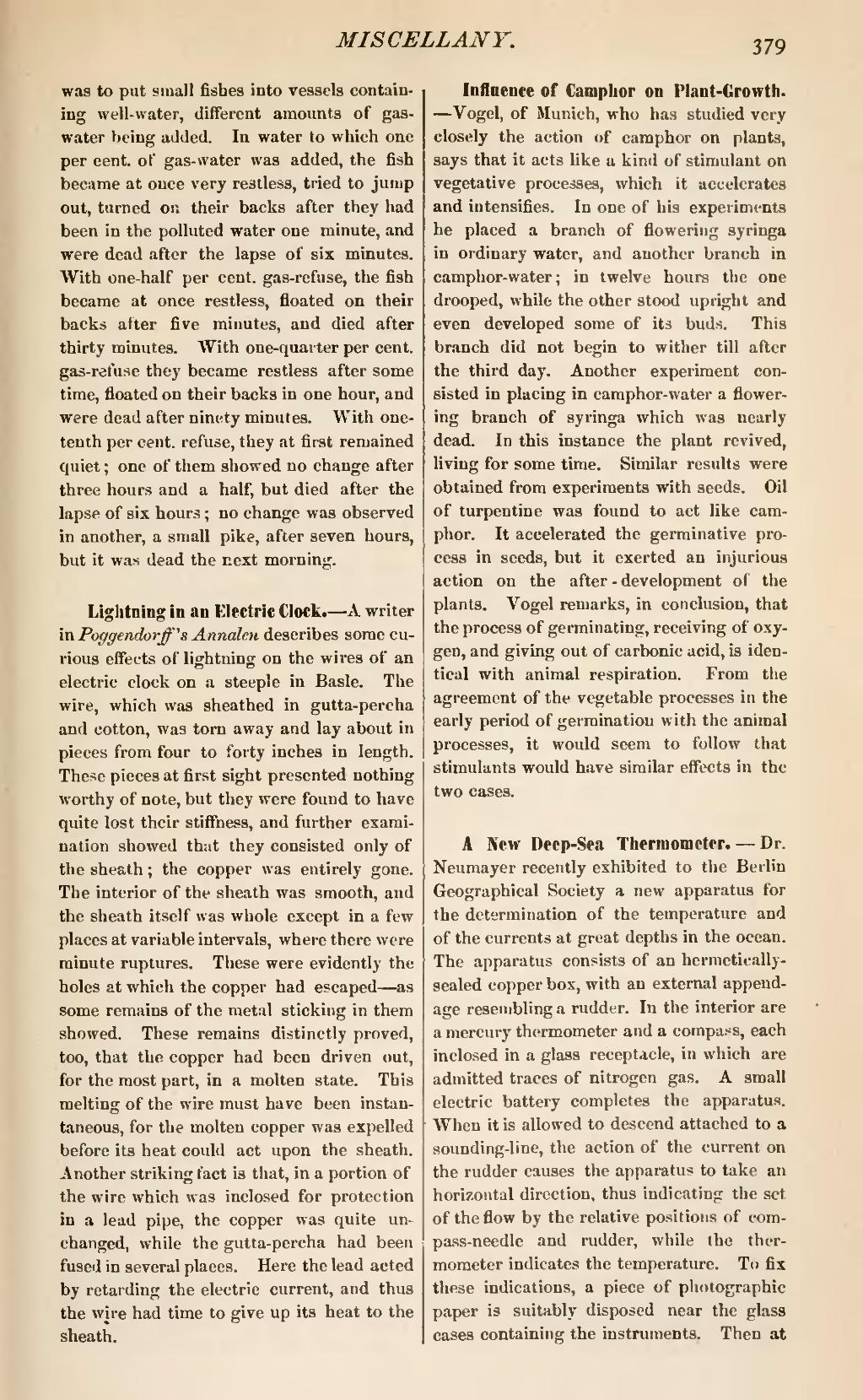was to put small fishes into vessels containing well-water, different amounts of gas-water being added. In water to which one per cent, of gas-water was added, the fish became at once very restless, tried to jump out, turned or. their backs after they had been in the polluted water one minute, and were dead after the lapse of six minutes. With one-half per cent, gas-refuse, the fish became at once restless, floated on their backs after five minutes, and died after thirty minutes. With one-quarter per cent, gas-refuse they became restless after some time, floated on their backs in one hour, and were dead after ninety minutes. With one-tenth per cent, refuse, they at first remained quiet; one of them showed no change after three hours and a half, but died after the lapse of six hours; no change was observed in another, a small pike, after seven hours, but it was dead the next morning.
Lightning in an Electric Clock.—A writer in Poggendorff's Annalen describes some curious effects of lightning on the wires of an electric clock on a steeple in Basle. The wire, which was sheathed in gutta-percha and cotton, was torn away and lay about in pieces from four to forty inches in length. These pieces at first sight presented nothing worthy of note, but they were found to have quite lost their stiffness, and further examination showed that they consisted only of the sheath; the copper was entirely gone. The interior of the sheath was smooth, and the sheath itself was whole except in a few places at variable intervals, where there were minute ruptures. These were evidently the holes at which the copper had escaped—as some remains of the metal sticking in them showed. These remains distinctly proved, too, that the copper had been driven out, for the most part, in a molten state. This melting of the wire must have been instantaneous, for the molten copper was expelled before its heat could act upon the sheath. Another striking fact is that, in a portion of the wire which was inclosed for protection in a lead pipe, the copper was quite unchanged, while the gutta-percha had been fused in several places. Here the lead acted by retarding the electric current, and thus the wire had time to give up its heat to the sheath.
Influence of Camphor on Plant-Growth.—Vogel, of Munich, who has studied very closely the action of camphor on plants, says that it acts like a kind of stimulant on vegetative processes, which it accelerates and intensifies. In one of his experiments he placed a branch of flowering syringa in ordinary water, and another branch in camphor-water; in twelve hours the one drooped, while the other stood upright and even developed some of its buds. This branch did not begin to wither till after the third day. Another experiment consisted in placing in camphor-water a flowering branch of syringa which was nearly dead. In this instance the plant revived, living for some time. Similar results were obtained from experiments with seeds. Oil of turpentine was found to act like camphor. It accelerated the germinative process in seeds, but it exerted an injurious action on the after-development of the plants. Vogel remarks, in conclusion, that the process of germinating, receiving of oxygen, and giving out of carbonic acid, is identical with animal respiration. From the agreement of the vegetable processes in the early period of germination with the animal processes, it would seem to follow that stimulants would have similar effects in the two cases.
A New Deep-Sea Thermometer.—Dr. Neumayer recently exhibited to the Berlin Geographical Society a new apparatus for the determination of the temperature and of the currents at great depths in the ocean. The apparatus consists of an hermetically-sealed copper box, with an external appendage resembling a rudder. In the interior are a mercury thermometer and a compass, each inclosed in a glass receptacle, in which are admitted traces of nitrogen gas. A small electric battery completes the apparatus. When it is allowed to descend attached to a sounding-line, the action of the current on the rudder causes the apparatus to take an horizontal direction, thus indicating the set of the flow by the relative positions of compass-needle and rudder, while the thermometer indicates the temperature. To fix these indications, a piece of photographic paper is suitably disposed near the glass cases containing the instruments. Then at
